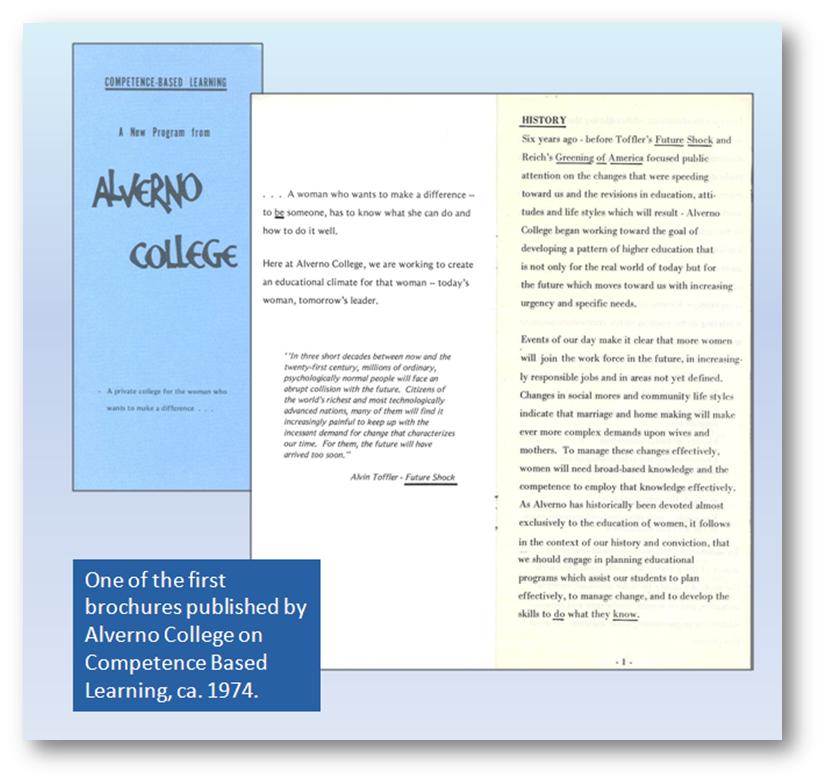Introduction
"As we have worked with our curriculum, we have come to an even deeper appreciation that 'curriculum' is a process, and our understanding and our practice have shifted over the years. What may look like definitions are really unfolding understandings, and what may look like a static articulated system is actually an evolving interactive process."
from the preface to Ability-Based Learning Outcomes: Teaching and Assessment at Alverno College, 2005
Alverno College tipped the academic scales of higher education when it initiated a new way of teaching and learning in 1973. With a cutting edge program dubbed CBL or “Competence Based Learning”, Alverno introduced the revolutionary idea of teaching students to learn, internalize, and then externalize and apply knowledge gained in the classroom to their life and their workplace.
There were many academic critics and skeptics in those first years of the program. However, more than forty years later, Alverno has prevailed as the acknowledged leader in the field of ability-based curriculum.

History
Beginning in 1964 and continuing through 1969, the Alverno administration recognized the impact that rapid changes in technology, the economy, politics and sociological shifts were having on the process of educating college students. The complexities of modern society were eroding away the effectiveness of traditional teaching techniques that had been used for centuries. Sensing a need for change, the Alverno administration invited faculty and students to a three day workshop dubbed "September '69" in order to meet and discuss the value and importance of higher learning. Curriculum integration and reorganization, the traditional grading system and the learning process itself were scrutinized, broken down and rebuilt. A new academic planning committee was developed to analyze and make recommendations based on all of the data collected at the meetings.
The outcome of the meetings and discussions culminated in an overhaul of Alverno’s traditional liberal arts curriculum which took almost four years. The core of Alverno’s new curriculum model would consist of eight abilities, experiential learning, mastery and assessment. The faculty would utilize the curriculum to encourage and direct students to apply broad-based knowledge learned within the context of a classroom and then effectively bridge the gap between the classroom and practical application within the workplace and community. Assessment and the eight ability levels would become the means for determining the depth of understanding and learning a student experienced while at Alverno College.
Upon entering Alverno College, students would begin their academic career with a baseline assessment of their ability to communicate thoughts and ideas in a variety of areas and to a variety of audiences: student peers, faculty, and external assessors. The entry level assessments would simulate “real life” situations allowing students to begin their process of learning by doing at Alverno. Entry assessments would provide a diagnostic tool for each student to learn about the process of self-assessment, professional feedback and the discovery of how assessment can be used as a compass to guide students on their learning paths. This new curriculum was finally launched in the fall of 1973.
What most clearly distinguishes Alverno’s learning process and assessment from testing is best described in the following quote from Sister Austin Doherty:
“Because assessment focuses on the application of abilities, students learn to tie knowledge, theory, motivation and self-perception to constructive action. They discover early that assessment is not a concluding step to learning; it is a natural part of every learning step we take.” In essence, each assessment concludes one step in the learning process while beginning the next. Alverno Magazine, July 1985, pg. 3-8.
More than forty years and thousands of students later, Alverno College continues to be in the forefront of academic institutions with innovative curricula that educate and prepare students for life and work outside of college. The ability-based curriculum continues to be tweaked and changed with the times. Our understanding of it continues to unfold.
For a good, very brief overview of the history of Alverno's ability-based curriculum, read , "Out of Crisis, Opportunity" from From reform of general education to transformation: Creating a culture of learning
(2009). [PDF]
Another useful overview of the early history of the Alverno Learning Process is a document from 1974 titled,
"Historical Background of the CBL Program." [PDF]
To read a good introductory article about Alverno's ability-based curriculum written by Pat Hutchings for the May 1991 issue of Alverno Magazine, click here. [PDF]
For another good article on the Alverno Learning Process that focuses on teaching from the Winter 1997 issue of Alverno Magazine, click here. [PDF]
For more information about the Alverno Learning Process, contact the Alverno College Archives or the
Alverno College Assessment and Outreach Center.
|